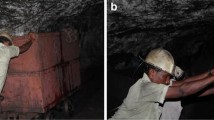Abstract
In India, progressively rigorous health, safety and environmental regulation, together with rapid technological advances have caused job demands of man machine interface. Any deviations in implementing rules and regulations leave many workers at severe risks. In different railway workshops where periodic overhauling (POH) of different coaches and locomotives are obtained, the exhaustive nature of work results strain within the workers. Unfortunately physiological work studies on railway workers are highly inadequate in India. The present study is aimed to relate the ergonomic intervention on the occupational stress of railway workshop’s fitters. Working heart rate (WHR) is measured continuously during their work schedule by portable heart rate monitor. Recovery heart rate and other essential occupational stress indexes are also measured along with total working environmental details. The working heart rate (WHR) of the subjects are found as 138 beats/min (bpm) and 121 bpm for the junior (age < 40 years) and senior fitters (age > 40 years), respectively. Net cardiac cost (NCC) and relative cardiac cost (RCC) values exhibit their range in a non-safe zone. No recovery in resting heart rate denotes the hostile environmental effect on the worker’s physiology. The effective temperature (ET) and wet bulb globe temperature (WBGT) of work site cross the recommended value. Clear evidences of a direct relationship between occupational hazard and fatigue is found and it can be considered as an environmental stresses which, in conjunction with other environmental and host factors induced a chronic fatigue that lead to non-specific health disorders.




Similar content being viewed by others
References
Jagadish, A. Ray, Multi-objective optimization of green EDM: An integrated theory, Springer Issue (India), Series C. Journal of The Institution of Engineers 96(1), 41–47 (2015)
N.C. Dey, G.D. Sharma, A critical study on the underground environment of coal mines in India–an Ergonomic Approach, Springer Issue. Journal of The Institution of Engineers (India), Series D 94(1), 1–6 (2013)
N.C. Dey, S. Pal, A look into miners health in prevailing ambience of underground coal mine environment Springer Issue. Journal of The Institution of Engineers (India), Series D 93(1), 37–42 (2012)
American Heart Association Committee of exercise; Exercise, testing and training of apparently healthy individual: A Handbook of Physician (AHA, New York, 1972)
Ramanathan et al, Energy cost of different muscular exercise tests performed by the Indian subjects, Indian Journal Occupational Health, 10, pp 253–61, 1967
D. DuBois, E.F. DuBois, Clinical Calorimeter X, A formula to estimate the approximate surface area if height and weight be known. Archives of Internal Medicine. 17, 863 (1916)
A.N. Naidu, N.P. Rao, Body mass index; A measure of the nutritional status in Indian populations. European journal of clinical nutrition 48(Supp 1), 131–140 (1994)
C.P. Yaglogou, D. Minard, Control of the heat casualties at military centers. AMA Archives of Industrial Health 16, 302–310 (1957)
P.O. Astrand, K. Rodhal, Textbook of Work Physiology (McGraw-Hill Publication, New York, 1986)
A. Chamoux, A.M. Borel, P. Catilina, for the standardization of a resting heart rate: heart rate nightly rest. Implications in evaluating the workload, Archives of occupational diseases occupational medicine and social security 46(4), 241–250 (1985)
B. Lablache-Combier, F.X. Ley, Using the continuous electrocardiographic recording of hot mine workings. Archives of occupational diseases occupational medicine and social security 45(5), 323–332 (1984)
G. C. Mookherjee, R. N. Sharma, A report on environment ‘Comfort Zone’ Journal of Science and Industrial Research, vol. 6, pp. 283–287, 1953
L. Brouha, Evaluation of the physiological requirements of jobs, Physiology in industry: evaluation of industrial stress by the physiological reaction of the workers. London, UK; Pergamon Press, pp. 82–108, 1960
TLVs, Threshold Limit Values for chemical substances and physical agents in the work room environment with intended changes (for 1981), Cincinnati, OH, USA (ACGIH), 1981
WHO, Health factors in working under conditions of heat stress, Geneva 412: WHO Tech. Rep. Series, 1969
Acknowledgement
Authors are thankful to the Chief of corresponding railway workshops along with Safety Officers, Production supervisors and the workers of railway workshop for their kind co-operation and cordial support.
Author information
Authors and Affiliations
Corresponding author
Rights and permissions
About this article
Cite this article
Mukhopadhyay, P., Dey, N.C. Ergonomic Intervention on the Occupational Stress of Selective Railway Workshop’s Fitters. J. Inst. Eng. India Ser. C 100, 59–64 (2019). https://doi.org/10.1007/s40032-017-0416-4
Received:
Accepted:
Published:
Issue Date:
DOI: https://doi.org/10.1007/s40032-017-0416-4




